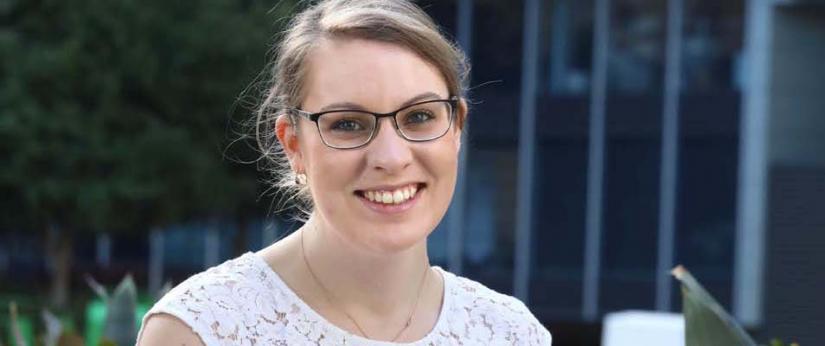We spoke to speech pathologist lecturer Lucy Bryant about her passion for speech pathology and everything in-between.

When Lucy Bryant was a child, she first met a speech pathologist for a lisp. At 14, her local audiologist – knowing she liked to talk – suggested a career in speech pathology. Flash forward to 2018, Lucy is a certified practising speech pathologist and lecturer at the Graduate School of Health.
Lucy completed her Bachelor of Speech Pathology (first class honours and university medal) and PhD at the University of Newcastle and has experience in both community and private clinical practice settings. Read more about Lucy in our Q+A below.
What were your motivations for becoming a speech pathologist?
When I was 14, I was asked by the local audiologist “what do you want to do when you finish school?”. I knew I wanted to work in allied health – in a profession that worked to improve the lives of people after illness or injury – but I hadn’t thought much beyond that. She knew me well (I had visited her often for hearing tests as a child) and she knew I loved to talk, so she suggested speech pathology.
I first met a speech pathologist when I was in pre-school. I had a lisp, and the speech pathologist recommended treatment. I remember practicing to say “s” sounds at home with my mum. Beyond that experience, I had no idea what a speech pathologist did, so I decided to investigate. I was immediately drawn to the idea that speech pathologists worked every day to improve lives, to help people express themselves and to access communication. From that moment I decided that when I grew up, I was going to be a speech pathologist.
I was immediately drawn to the idea that speech pathologists worked every day to improve lives, to help people express themselves and to access communication.
What do you enjoy most about speech pathology?
I love to talk! Talking and communication are such an important part of what it means to be human. Communication is how we connect with others and with the world around us. Every person has the right to communicate, to express themselves – their wants and needs and opinions. I am a speech pathologist because I want to help people to communicate and connect through language, and I’m so lucky that I get to do that every day.
Why did you choose the Graduate School of Health?
The way people communicate is changing as technology develops and becomes a bigger part of our everyday lives. That impacts on our communication, and it introduces so many new and exciting innovations that we can use in our practice as speech pathologists to reach and help our clients.
Speech Pathology at the Graduate School of Health (GSH) sits within the vibrant and collaborative community of UTS that has a clear view to the role that technology will play in our future. My role opens so many opportunities to innovate and integrate technology into research, teaching and clinical education with the team at GSH.
You’ll be lecturing our new Master of Speech Pathology students. Can you tell us a bit about this?
I’m really looking forward to the opportunity to teach our students about Speech Pathology. I will be lecturing about language and linguistics, and teaching our students about research and clinical practice. It’s such an exciting time to be doing this, with all the amazing technology and innovation that our students can access and learn. Society and communication rely more and more on our interaction with technology. Our students will be learning about virtual and augmented realities, and using mobile technology to deliver assessments and therapy. This is the cutting edge and the future of Speech Pathology and we will be using it in teaching and in practice from the very beginning of the course.
What were you doing prior to joining GSH?
Since graduating as a speech pathologist, I have worked in community health and private practice clinics, working with children with speech, language, literacy, fluency and feeding disorders. I loved working in rural Australia, where as a speech pathologist you work with the entire community. I was so lucky to see clients of all ages, from only a few days old to elderly adults in nursing homes.
I have also worked in research on a number of projects that aim to improve the safety of people with communication disability in hospitals and use of the My Health Record.
Can you tell us about your research and what you hope to achieve?
My interest lies in technology – the role it plays in our communication, how it can be used as a tool in speech pathology and rehabilitation, and how the increasing interaction with technology impacts on our use of language. In particular, I’m fascinated by the rapid development of Virtual Reality technology. We need to know more about how this technology can be used to help people with communication disability to develop their language and communication skills.
What can we expect from you in the future?
One of the best things about being a speech pathologist is that there are so many options when you look to the future! There is rewarding work to be done in teaching, research, and in the delivery of clinical services to so many different groups of people. My goals are to provide high quality, engaging and practical teaching and clinical education at UTS to help shape the next generation of future-ready speech pathologists. I’m also incredibly excited to establish a collaborative program of research investigating applications of Virtual Reality technologies to speech pathology and communication.
Start your journey in Speech Pathology at the Graduate School of Health

